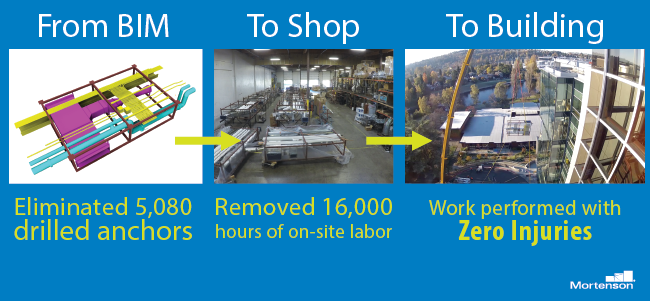By Bryan Maggio

Having completed hundreds of renovation and tenant improvement projects inside some of country’s busiest hospitals, our Mortenson team members understand the inherent risks that construction activities impose on patients, families, care professionals and staff.
These risks exist in the form of airborne contaminates, breaches in life safety systems, unplanned utility disruptions, and exposure to hazardous materials. Even when all those risks are fully mitigated, construction will always be a disruptive presence on any active medical campus. This is especially true when it comes to multi-phased, long duration projects where months to years of access reroutes, utility shutdowns, and intermittent noise and vibration almost always results in “construction fatigue” by those who work and are cared for in the affected areas.
A patient-centric approach based on meticulous planning is essential to overcoming the unavoidable set of challenges that construction presents.
While the development of comprehensive infection control and interim life safety programs is always at the forefront of every healthcare project execution plan, equally essential to supporting patient care and operational continuity is effective disruption avoidance planning. Unanticipated disruptions are not only costly and time consuming for a project team, but they can negatively affect the patient experience and damage our customers’ reputation, as experts in this avoidance planning, Mortenson can provide several solutions and detailed planning to be proactive in these situations.
During the design and preconstruction stages, Disruption Avoidance Plans should be developed for each phase of work, and factor in potential impacts such as noise, vibration, utility interruptions, security, access limitations, wayfinding, etc. Created in collaboration the customer’s unique stakeholders of each phase, these plans should be revisited during and after execution to ensure lessons learned and best practices are carried forward to the next.
Part of the planning process should include ideating opportunities for prefabrication and offsite assembly to reduce the amount of construction occurring on campus or inside the facility. As part of the University of Washington Medical Center’s Expansion Phase II project, Mortenson’s scope included the build-out of three inpatient bed floors – including two 24-bed intensive care units. Given the extent of the above-ceiling MEP rough-ins required to serve these high-acuity areas, a major area of concern was the large sum of hanger rods that would have to be drilled into the concrete deck. Mitigating the impact of noise and vibration to the adjacent, active inpatient units became the project team’s number one priority during preconstruction planning. Their solution, to take as much of the above-ceiling work as possible out of the medical center.
Working with our electrical and mechanical trade partners, Mortenson setup a pre-fabrication shop offsite for building multi-trade MEP racks. Modeled and coordinated using BIM, the completed racks were shrink wrapped, trucked to the site, boomed onto the floors through a temporary opening created in the façade, and hung in place. This alternative approached yielded the elimination of over 5,000 drilled anchors, and removed more than 16,000 hours of labor from the medical center.
While we would never suggest that a construction project inside an active facility can be “invisible,” through creative and disciplined planning our teams are able to greatly mitigate the impact our presence has on our customer’s operations. We have leveraged the knowledge and experience of our integrated teams in the successful creation and implementation thousands of such plans that integrate our construction activities with the ongoing activities of a medical campus.
At Mortenson we view our role as an extension of our customers’ care teams, and share in their mission of providing an outstanding experience for their patients, families, and staff; because HOW our work gets done is just as important as when, and how much it costs.